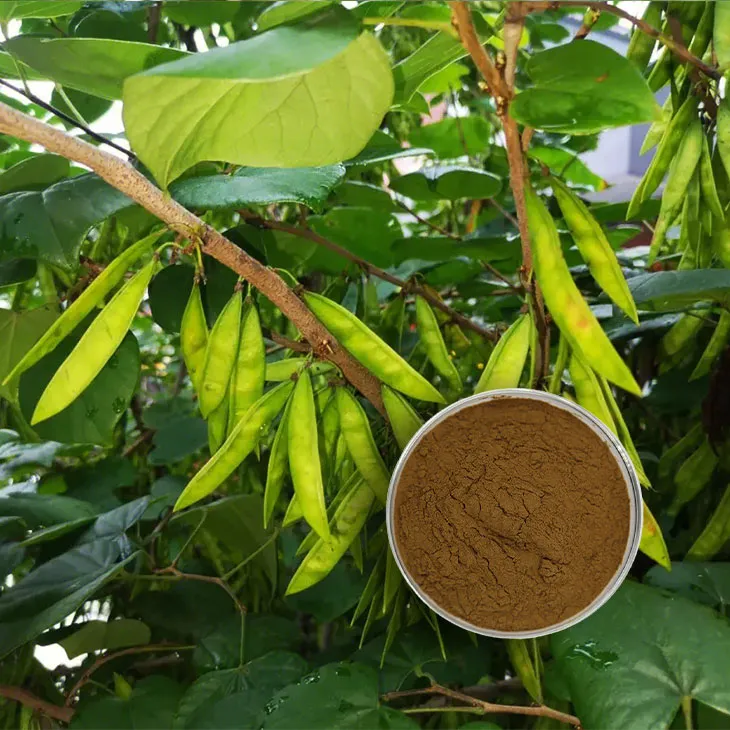- 0086-571-85302990
- sales@greenskybio.com
Saponin Extraction: A Holistic Overview of Processes, Applications, and Prospects
2024-07-05

1. Introduction
Saponins are a diverse group of natural compounds that have attracted significant attention in various fields. They are widely distributed in plants, and their unique chemical properties make them valuable for multiple applications. Saponin Extraction is the crucial first step in harnessing their potential, which is a complex process influenced by numerous factors. This article aims to provide a comprehensive understanding of Saponin Extraction, including the processes involved, their applications, and future prospects.

2. Saponin Extraction Processes
2.1. Solvent Extraction
Solvent extraction is one of the most common methods for saponin extraction. Different solvents can be used depending on the nature of the plant material and the target saponins.
- Ethanol is a popular solvent. It has the advantage of being relatively safe, easily available, and can effectively dissolve saponins. For example, in the extraction of saponins from ginseng, ethanol - based extraction methods have been widely studied. The plant material is typically soaked in ethanol for a certain period, and then the extract is filtered and concentrated to obtain the saponin - rich fraction.
- Methanol is also used in some cases. However, it is more toxic than ethanol, so special safety precautions are required during the extraction process. But methanol can have a higher solubility for some types of saponins, which makes it a suitable choice when dealing with certain plant species with complex saponin profiles.
2.2. Supercritical Fluid Extraction
Supercritical fluid extraction (SFE) is an advanced extraction technique. Carbon dioxide (CO₂) is the most commonly used supercritical fluid in saponin extraction.
- The process operates under specific temperature and pressure conditions, where CO₂ reaches its supercritical state. In this state, CO₂ has properties between those of a gas and a liquid, which allows it to penetrate the plant matrix effectively and selectively extract saponins.
- One of the main advantages of SFE is its ability to produce a cleaner extract compared to traditional solvent extraction methods. Since CO₂ is a gas at normal conditions, it can be easily removed from the extract, leaving behind minimal solvent residues. This is particularly important in applications where purity is highly demanded, such as in the pharmaceutical industry.
- However, the equipment for SFE is relatively expensive, which may limit its widespread use in small - scale or resource - limited settings.
2.3. Microwave - Assisted Extraction
Microwave - assisted extraction (MAE) is a relatively new technique in saponin extraction.
- The principle behind MAE is that microwaves can heat the plant material and the solvent rapidly and uniformly. This leads to an increase in the extraction efficiency as the heat promotes the release of saponins from the plant cells. For example, in the extraction of saponins from certain leguminous plants, MAE has shown to significantly reduce the extraction time compared to traditional methods.
- The main factors influencing the efficiency of MAE include the microwave power, extraction time, and the ratio of plant material to solvent. By optimizing these parameters, a high - quality saponin extract can be obtained.
- However, one potential drawback of MAE is that over - exposure to microwaves may cause degradation of some saponins, so careful control of the extraction conditions is essential.

3. Applications of Saponins
3.1. Medicinal Applications
Saponins have a wide range of medicinal properties, which have been exploited in traditional and modern medicine.
- Anticancer Activity: Some saponins have been shown to have potential anticancer effects. For instance, certain saponins from plants like Panax notoginseng can induce apoptosis (programmed cell death) in cancer cells. They can also inhibit the growth and metastasis of tumors by interfering with various signaling pathways involved in cancer development.
- Immunomodulatory Effects: Saponins can modulate the immune system. They can enhance the activity of immune cells such as macrophages and lymphocytes, which play important roles in fighting infections and diseases. For example, some herbal remedies containing saponins are used to boost the immune system during the cold and flu season.
- Anti - inflammatory Properties: Saponins can reduce inflammation in the body. They act by inhibiting the production of inflammatory mediators such as cytokines and prostaglandins. This makes them useful in the treatment of inflammatory diseases like arthritis.
3.2. Applications in Beauty Products
Saponins are also widely used in the beauty industry.
- Skin Cleansing: Saponins have natural surfactant properties, which make them excellent ingredients for skin - cleansing products. They can form a lather that helps to remove dirt, oil, and impurities from the skin without causing excessive dryness. Many natural soaps and facial cleansers contain saponins derived from plants such as soapwort.
- Hair Care: In hair care products, saponins can improve the condition of the hair. They can add shine, reduce frizz, and strengthen the hair shaft. For example, some shampoos and conditioners contain saponins from plants like yucca, which can help to keep the hair healthy and manageable.
- Anti - aging Effects: Some saponins have antioxidant properties, which can help to prevent premature aging of the skin. They can scavenge free radicals, which are responsible for causing damage to skin cells and accelerating the aging process.
3.3. Agricultural Applications
Saponins also play important roles in agriculture.
- Pesticide Activity: Some saponins have pesticidal properties. They can act as natural insecticides, repelling or killing pests that attack plants. For example, saponins from certain plants can be used to control aphids and other common agricultural pests, reducing the need for synthetic pesticides.
- Growth Promotion: Saponins can also promote plant growth. They can enhance the uptake of nutrients by plants, improve soil structure, and stimulate the growth of beneficial microorganisms in the soil.

4. Future Prospects of Saponin Extraction
4.1. Technological Advancements
With the continuous development of technology, there are several trends that will likely impact saponin extraction in the future.
- Improved Extraction Equipment: Newer extraction equipment is expected to be more energy - efficient and precise. For example, the development of advanced supercritical fluid extraction devices may reduce the cost of SFE, making it more accessible for small - and medium - sized enterprises. These new devices may also offer better control over extraction parameters, resulting in higher - quality saponin extracts.
- Integration of Multiple Extraction Techniques: There is a growing trend towards combining different extraction techniques. For instance, microwave - assisted supercritical fluid extraction could potentially combine the advantages of both MAE and SFE, resulting in a more efficient and cleaner extraction process.
- Automation and Process Control: Automation will play an increasingly important role in saponin extraction. Automated systems can ensure consistent extraction quality by precisely controlling factors such as temperature, pressure, and extraction time. This will not only improve the quality of the final product but also reduce the labor intensity associated with the extraction process.
4.2. Emerging Market Trends
The market for saponin - based products is also expected to experience significant growth in the future.
- Increasing Demand for Natural Products: Consumers are becoming more health - conscious and are increasingly seeking natural alternatives to synthetic products. Saponins, being natural compounds, are well - positioned to meet this demand. This is particularly true in the fields of medicine, beauty, and food, where there is a growing preference for natural ingredients.
- Expansion in the Pharmaceutical Industry: As research on the medicinal properties of saponins continues to advance, there is likely to be an expansion in the use of saponins in the pharmaceutical industry. New drugs based on saponins may be developed, targeting various diseases such as cancer, diabetes, and autoimmune disorders.
- Growth in the Beauty and Cosmetics Market: The beauty and cosmetics market is constantly evolving, and there is a growing demand for products with natural and effective ingredients. Saponins, with their multiple benefits for the skin and hair, are expected to gain more popularity in this market segment.
4.3. Challenges and Opportunities
Despite the promising prospects, there are also several challenges that need to be addressed in the future of saponin extraction.
- Standardization of Extraction Processes: There is currently a lack of standardized extraction processes for saponins, which can lead to variations in product quality. Developing standardized extraction protocols will be crucial for ensuring the consistency and safety of saponin - based products.
- Sustainable Sourcing of Plant Materials: As the demand for saponins increases, it is essential to ensure the sustainable sourcing of plant materials. This requires the development of sustainable cultivation methods and the protection of wild plant species that are rich in saponins.
- Regulatory Hurdles: In some cases, the regulatory environment for saponin - based products can be complex. For example, in the pharmaceutical and food industries, strict regulations govern the use of natural products. Overcoming these regulatory hurdles will be necessary for the wider commercialization of saponin - based products.

5. Conclusion
Saponin extraction is a multi - faceted field with significant potential. The various extraction processes, each with its own advantages and limitations, provide different options for obtaining saponins. Their wide - ranging applications in medicine, beauty, and agriculture highlight their importance in different industries. Looking ahead, the future prospects of saponin extraction are promising, with technological advancements and emerging market trends offering opportunities for growth. However, challenges such as standardization, sustainable sourcing, and regulatory issues need to be addressed to fully realize the potential of saponins. Overall, continued research and development in this area are essential to unlock the full benefits of these remarkable natural compounds.
FAQ:
What are the common extraction procedures for saponins?
There are several common extraction procedures for saponins. One is the solvent extraction method, which involves using solvents like ethanol or methanol to dissolve saponins from the raw materials. Another is the ultrasonic - assisted extraction, where ultrasonic waves are used to enhance the extraction efficiency by breaking cell walls and facilitating the release of saponins. Supercritical fluid extraction is also an option, often using supercritical carbon dioxide, which has the advantages of being environmentally friendly and producing high - purity extracts.
How do saponins contribute to medicinal treatments?
Saponins play significant roles in medicinal treatments. They can exhibit anti - inflammatory properties, which can be helpful in reducing inflammation in various diseases. Some saponins have been found to possess anti - cancer activities, either by inducing apoptosis in cancer cells or inhibiting tumor growth. They may also have immunomodulatory effects, enhancing the body's immune system to fight against diseases.
What are the applications of saponins in beauty products?
In beauty products, saponins are widely used. They can act as surfactants, which helps in cleansing the skin and hair by reducing the surface tension between substances. Saponins also have antioxidant properties, which can protect the skin from oxidative damage caused by free radicals, thus delaying skin aging. Additionally, they may have anti - microbial properties, which can prevent skin infections.
How will technological advancements impact saponin extraction?
Technological advancements will have a great impact on saponin extraction. New extraction techniques may be developed, such as more efficient and energy - saving methods. Advanced separation and purification technologies can improve the purity of saponin extracts. Moreover, technological advancements in analytical instruments can help in better understanding the chemical composition and properties of saponins, enabling more targeted extraction and utilization.
What are the emerging market trends related to saponins?
The emerging market trends related to saponins include an increasing demand for natural products in various industries. In the food and beverage industry, there is a growing interest in using saponin - rich plants as functional ingredients. In the pharmaceutical and cosmetic industries, the trend is towards high - quality and sustainable saponin products. Additionally, the development of new saponin - based drugs and beauty products is also an emerging trend.
Related literature
- Saponin - Rich Plants: Sources, Extraction and Applications"
- "Advances in Saponin Research: From Extraction to Therapeutic Applications"
- "The Role of Saponins in Cosmetics: Properties and Potential"
- ▶ Hesperidin
- ▶ citrus bioflavonoids
- ▶ plant extract
- ▶ lycopene
- ▶ Diosmin
- ▶ Grape seed extract
- ▶ Sea buckthorn Juice Powder
- ▶ Beetroot powder
- ▶ Hops Extract
- ▶ Artichoke Extract
- ▶ Reishi mushroom extract
- ▶ Astaxanthin
- ▶ Green Tea Extract
- ▶ Curcumin Extract
- ▶ Horse Chestnut Extract
- ▶ Other Problems
- ▶ Boswellia Serrata Extract
- ▶ Resveratrol Extract
- ▶ Marigold Extract
- ▶ Grape Leaf Extract
- ▶ blog3
- ▶ Aminolevulinic acid
- ▶ Cranberry Extract
- ▶ Red Yeast Rice
- ▶ Red Wine Extract
-
Aguaje Extract
2024-07-05
-
Horse Chestnut Extract
2024-07-05
-
Curcuma Longa Extract/Turmeric extract
2024-07-05
-
Polygonum multiflorum extract
2024-07-05
-
Plantain extract
2024-07-05
-
Fenugreek Extract Powder
2024-07-05
-
Ginseng Root Extract
2024-07-05
-
Andrographis Paniculata Extract Powder
2024-07-05
-
Black Pepper Extract
2024-07-05
-
Camu Camu Extract
2024-07-05





















